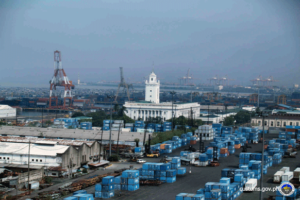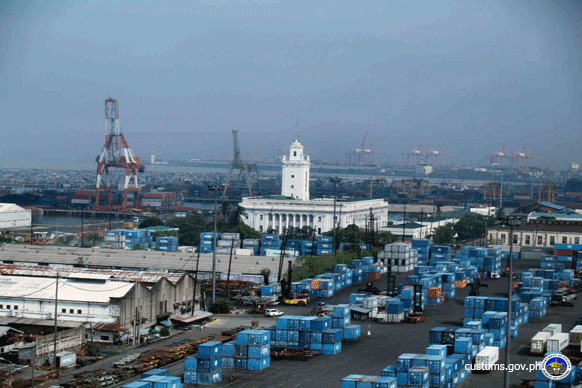 Port and customs authorities said there is no port congestion in Manila ports, as claimed by Senator Aquilino Pimentel III.
Port and customs authorities said there is no port congestion in Manila ports, as claimed by Senator Aquilino Pimentel III.
Pimentel on September 3 bared plans to summon BOC officials to account for “slower movement and longer delays” in the release of imported shipments at the Manila ports.
“No port congestion as defined by internationally accepted industry indicators. Mataas lang ang (There is high) volume that’s why we experience delays,” Bureau of Customs (BOC) spokesperson and Port of Manila district collector Atty. Erastus Sandino Austria told PortCalls in a text message.
Austria said there is currently high yard utilization, which is due to overstaying empty containers taking up space in the yard, and other factors in the logistics chain that is out of BOC’s control.
For July, the combined yard utilization at Manila ports (Port of Manila and Manila International Container Port) is 60%, according to a Philippine Ports Authority (PPA) statement.
“The delay is outside, in the entire logistics chain that is beyond our jurisdiction and control. Nevertheless, we are at the forefront in resolving them,” Austria noted. He said “concrete solutions are underway” and being negotiated with the port operator of the Manila South Harbor (also referred to as the Port of Manila), Asian Terminals Inc (ATI).
Austria also noted that BOC clearance “takes minutes to hours only if all docs are complete and correct.”
An official of the PPA likewise told PortCalls there is no port congestion in Manila’s international terminals—Manila South Harbor and Manila International Container Port.
South Harbor port operator ATI, in a statement, said that as of September 4, “there are no vessels waiting to dock at Manila South Harbor, with berth utilization at a healthy 50%.”
Crane production is averaging at least 25 moves per crane per hour while yard utilization averages 76%.
According to the Center for the Advancement of Trade Integration and Facilitation, the ideal port optimization is at 70% of capacity. In the paper titled Study of Container Terminal Planning by Professor Nam-Kyu Park of Tongmyong University Department of Logistics Management and associate professor Branislav Dragović of University of Montenegro Maritime Faculty, based on the opinion of terminal operators, a container yard capacity occupancy ratio of 60% is suitable for smooth workflow of the whole container terminal.
Pimentel, who chairs the Senate Committee on Trade, Commerce and Entrepreneurship, revealed in a September 3 statement that he has been receiving a growing number of complaints from importers, traders, truckers, customs brokers, and overseas Filipino workers (OFW) associations claiming “worsening port congestion at the Manila Port.”
“Vessels now take around 4-5 days to berth at the pier. After berthing, it takes around 2-3 days to unload containers at the yard. So it takes 7-10 days to unload a container. The longer these containers stay unreleased, the higher the added storage charges incurred, which are eventually passed on to us consumers. That’s only one problem,” Pimentel claimed.
Consumer and OFW groups in particular, Pimentel noted, pointed to the “longer time it takes these days to release balikbayan [personal effects] boxes.”
“I want to hear solutions from Customs officials and other stakeholders. Port congestion is a serious threat to the economy. We don’t want a slowdown in commerce this coming Christmas season all because volume may have to be scaled down as a result of inefficiency in our ports, in Manila in particular,” Pimentel said.
BOC’s Austria, however, noted that port congestion has been in BOC’s radar, and was even tackled during a stakeholders’ forum organized by the customs bureau last July.
The National Economic and Development Authority pegged at P2.5 billion economic losses that resulted from port congestion at Manila ports in 2014. About the same amount is lost daily due to Manila’s worsening traffic situation.
Pimentel said a more comprehensive solution to the port problem needs to be formulated to address the congestion mess.
“Some years ago, several banks at the Manila Port extended their operating hours to accommodate clearance payments for shipments. At this point, however, we need bigger, more long-term solutions. For example, we simply cannot rely on truck bans anymore. We need dedicated roads linking the port to our skyways and expressways,” he said.
Key infrastructure components should be made integral parts of the government’s Build, Build, Build infrastructure program, he emphasized.
The lawmaker likewise suggested eventually de-clogging the capital’s operations and expanding alternative gateways in Subic and Batangas.
“This serious national economic matter may require Senate intervention in, first, probing the problem further and, second, in bringing about solutions through an inquiry called for such purpose. We need the BOC to urgently shed light on these issues,” Pimentel said. – Roumina Pablo





